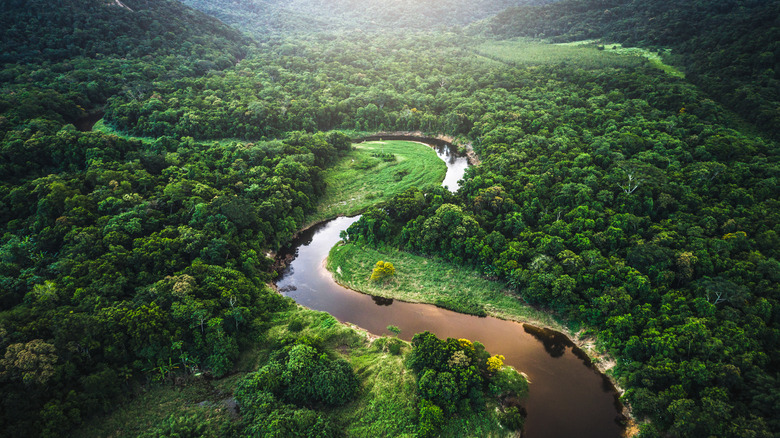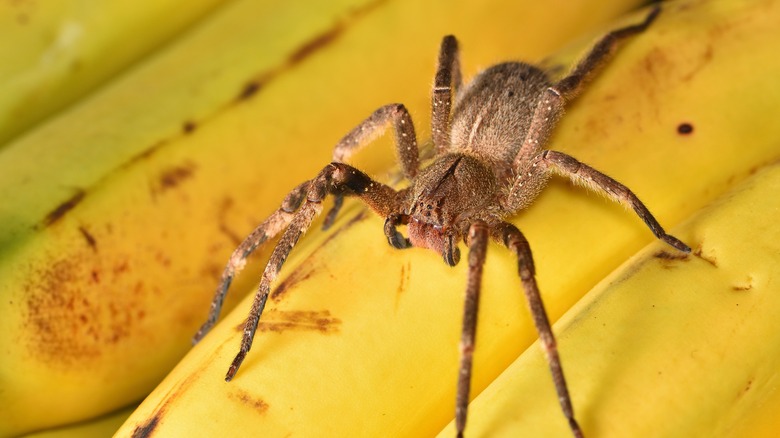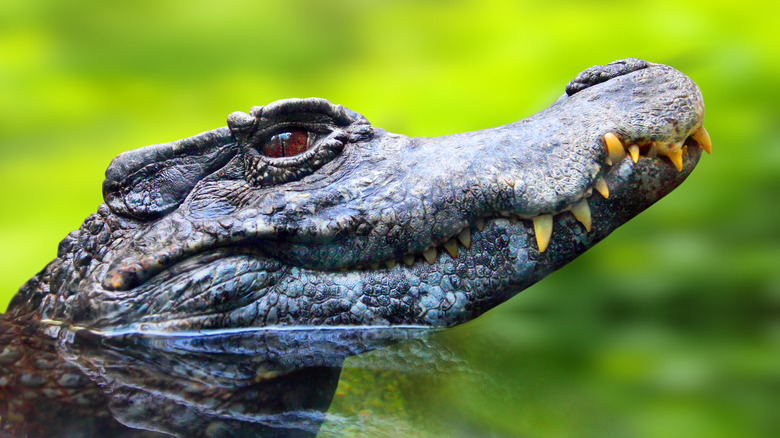5 Creatures To Beware Of When Adventuring In The Amazon Rainforest
We may receive a commission on purchases made from links.
The Amazon Rainforest, spanning over 2.3 million square miles, is not only the largest tropical rainforest on Earth but also one of the most biodiverse ecosystems in the world. It is estimated to be home to approximately 10% of the world's known species, including an astounding array of plants, animals, and microorganisms. Within its dense vegetation and winding waterways, the Amazon harbors an estimated 390 billion trees, representing an astonishing 16,000 species, according to EarthDay.org.
However, beneath this lush expanse lies a realm fraught with danger, where encounters with wildlife can swiftly turn perilous. Amazon Conservation reports that the South American rainforest is home to an estimated 427 mammal species, as well as over 1,300 species of birds, many of which possess formidable talons and beaks. Additionally, the rivers and streams of the Amazon teem with life, hosting an estimated 2,500 species of fish — and even more yet to be documented, per Brittanica. Among the known species, though, are the notorious piranhas and electric eels.
However, appearances can be deceiving, and not all of these creatures are as benign as they may seem. In this guide, we delve into the dangerous wildlife that inhabits the Amazon Rainforest, exploring their behaviors, the dangers they pose, and essential tips for minimizing risk while exploring this extraordinary ecosystem. Join us as we embark on a journey through the heart of the Amazon, where every step brings us closer to the wonders and perils of the natural world.
Jaguar
Jaguars, revered as the largest big cats in the Americas, command respect as majestic predators roaming the labyrinthine depths of the Amazon Rainforest. With their sleek, muscular forms, they epitomize stealth and prowess in the dense jungle terrain. Proficient hunters, jaguars often prowl the vicinity of water sources, such as meandering rivers and babbling streams, where their prey congregates. Their silent movements and cryptic coats allow them to seamlessly blend into the lush vegetation and forested expanses, employing ambush tactics to secure their next meal.
Despite their preference for wild game, jaguars' encounters with humans can prove perilous, particularly in regions where human activity encroaches upon their natural habitat. The delicate balance of the Amazon Rainforest, already vulnerable to disruption, is further strained by these confrontations. Jaguar attacks, although infrequent, typically stem from defensive instincts or feelings of threat and confinement. When unknowing tourists inadvertently encroach upon their territory or their offspring, jaguars may perceive them as potential threats and react defensively.
In the unfortunate event of a jaguar attack, the consequences can be dire, owing to the feline's formidable size and strength. With razor-sharp claws and powerful jaws, they can inflict deep, grievous wounds upon their victims. When a jaguar strikes, its claws can tear through flesh with alarming ease, leaving deep, dire wounds in their wake. Immediate medical attention becomes paramount, offering the only hope of averting potentially fatal outcomes and mitigating the devastating aftermath of such encounters.
Brazilian wandering spider
The Brazilian wandering spider, also known as the "armed spider" or "banana spider," is considered one of the most venomous spiders in the world. As their name suggests, Brazilian wandering spiders are known for their wandering behavior rather than residing in a fixed web. Preferring the cover of darkness, they seek refuge in obscure, sheltered spaces like banana leaves during daylight hours, emerging under the cloak of night to hunt for prey. Such nocturnal activity underscores the need for caution among adventurers traversing the Amazon's depths.
Even so, Brazilian wandering spiders are not inherently aggressive towards humans and typically only bite when they feel threatened or cornered, reserving their venomous bite for those moments. When that happens they display their readiness to defend themselves by assuming an aggressive posture, raising their front legs high in the air.
If you encounter a Brazilian wandering spider in the wild or anywhere else, it's essential to exercise caution to avoid provoking it. Do not attempt to handle or approach the spider, as this may increase the risk of a defensive bite. Instead, calmly move away from the spider and alert others to its presence. If bitten by a Brazilian wandering spider, the effects can be severe due to the potency of their venom. According to a study in Plos One, its venom contains a potent neurotoxin that can cause severe symptoms, including intense pain, paralysis, and in rare cases, death. Immediate medical attention is crucial to administer appropriate treatment and manage symptoms.
Piranha
Visitors should exercise caution not only amidst the dense foliage of the Amazon but also within its treacherous waters. In its rivers, lakes, and streams reside piranhas, creatures renowned for their infamous sharp teeth, aggressive feeding behavior, and deadly reputation.
Contrary to their reputation, however, piranhas do not pose major threats to humans directly. They do not actively seek out humans as prey, but they may bite if they perceive a threat or mistake a person for food, especially if they are attracted by blood. Piranha bites can cause significant injuries due to their razor-sharp teeth and powerful jaws. Though painful, the bites of an individual fish are unlikely to be lethal. But if you get attacked by a swarm of piranhas, and receive multiple wounds, leading to severe bleeding and tissue damage, you will need immediate medical attention to clean and treat the wounds to prevent infection.
If you encounter piranhas while in the water, it's essential to avoid sudden movements or splashing that could attract their attention. If possible, calmly exit the water to minimize the risk of a piranha bite. Avoid swimming in areas where piranhas are known to inhabit and heed local warnings or advice regarding their presence. If you're fishing in piranha-infested waters, take precautions to prevent accidental bites, such as using a sturdy fishing line and avoiding handling fish with bare hands.
Green anaconda
Among the heaviest and longest snakes on Earth, green anacondas are iconic inhabitants of the Amazon Rainforest. As their name suggests, green anacondas are primarily olive-green in color with black blotches along their bodies. This coloration helps them blend in with the greenery and murky waters they live in.
Anacondas generally don't display aggression toward humans and tend to steer clear of conflict when possible, which is likely why they aren't ranked among the most dangerous snakes in the world. Nevertheless, as apex predators, they pose a threat if provoked or feel endangered. Alarmingly, these serpents have the ability to stay submerged for prolonged periods, blending seamlessly with their surroundings. While entranced by the rich biodiversity of the Amazon, you might stumble upon an anaconda without intending to, inadvertently startling it. That's why it's essential to remain vigilant.
Anacondas are ambush predators, lying in wait for prey to pass by before striking with lightning speed. Once within striking range, they use their muscular bodies to wrap around their prey and squeeze tightly, preventing escape. Their massive size and strength enable them to overpower prey as large and as violent as caimans. If you encounter an anaconda in the wild, it's crucial to remain calm and avoid startling or provoking the snake. Back away slowly and give the anaconda space to retreat. Attempting to handle or capture the snake is not advisable and can lead to dangerous consequences for both you and the anaconda.
Black caiman
Black caimans are highly dangerous predators in the Amazon Rainforest. Of all the caiman species, they are the largest, growing over 15 feet long. This impressive size, coupled with their muscular build and streamlined bodies, enables them to navigate the murky waters of swamps and rivers with remarkable agility and stealth. Furthermore, black caimans are skilled swimmers, capable of traversing both shallow marshlands and deep river channels with ease, allowing them to pursue prey in the water and make fast escapes when needed.
While black caiman attacks on humans are relatively rare, they can occur, especially in situations where humans encroach upon their habitat or threaten their offspring. Caimans may perceive humans as potential threats and may attack if they feel provoked, cornered, or defending their territory.
If you spot a caiman while near water, it's advisable to keep a safe distance and move away, to reduce any possibility of being viewed as a threat. Though the primarily live in water, there have been reports of these crocodiles moving onto land in order to hunt down mammals. Being attacked by a black caiman can have severe consequences due to their sheer size and strength. Their powerful jaws are capable of inflicting deep puncture wounds and causing significant tissue damage. Surviving a caiman attack requires immediate medical attention, as wounds can become infected and lead to serious complications.





